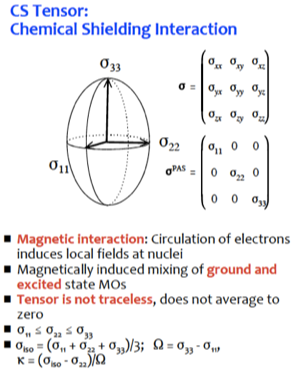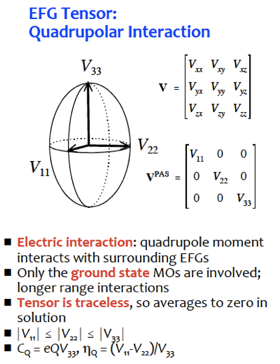Single- and multiple-spin interactions lead to interest perturbing effects on NMR spectra. These include chemical shielding, the quadrupolar interaction, direct (dipolar) spin-spin coupling and indirect (scalar) spin-spin coupling. Our research group focuses effort on characterizing the single spin tensors (chemical shift and quadrupolar) by both experimental and theoretical methods.
These NMR interactions are said to be anisotropic (i.e., orientation dependent); hence, if crystals or crystallites are oriented differently with respect to the magnetic field of the NMR magnet, different frequency shifts arise. In solution NMR, these anisotropic effects are typically averaged, and we only observe the isotropic frequency shifts. The anisotropic NMR interactions are described by second-rank tensors (see pictures below).
These NMR interactions are said to be anisotropic (i.e., orientation dependent); hence, if crystals or crystallites are oriented differently with respect to the magnetic field of the NMR magnet, different frequency shifts arise. In solution NMR, these anisotropic effects are typically averaged, and we only observe the isotropic frequency shifts. The anisotropic NMR interactions are described by second-rank tensors (see pictures below).
Chemical shielding
Chemical shielding or nuclear magnetic shielding is a magnetic effect arising from electron motion induced by the external magnetic field. Chemical shielding is measured with respect to a bare nucleus (shift of 0 ppm), whereas chemical shifts are measured with respect to a standard sample.

Quadrupolar interaction
The quadrupolar interaction, which only exists for quadrupolar nuclei (spin > 1/2), is an electrical in nature, arising from the interaction between the nuclear electric quadrupolar moment and surrounding electric field gradients (EFGs) with the origin a the position of the nucleus.

For information on NMR interaction tensors, check out my review articles:
- C.M. Widdifield and R.W. Schurko, 2009. Understanding Chemical Shielding Tensors Using Group Theory, MO Analysis and Modern Density-Functional Theory. Conc. Magn. Reson. 34A, 91-123. Invited article. DOI: 10.1002/cmr.a.20136
- J. Autschbach, S. Zheng and R.W. Schurko, 2010. Analysis of Electric Field Gradient Tensors at Quadrupolar Nuclei in Common Structural Motifs. Conc. Magn. Reson. 36A, 84-126. DOI: 10.1002/cmr.a.20155
Other useful links:
